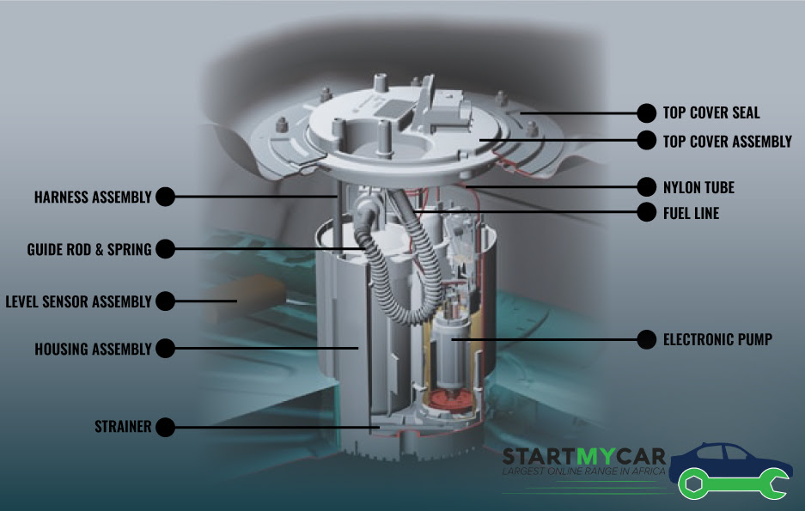You have no items in your shopping cart.

Virtually all modern vehicles with internal combustion engines come equipped with fuel pumps. The fuel pump is responsible for delivering fuel from the fuel tank to the engine at the appropriate pressure required for performance demands. The pump is commonly located inside the fuel tank. Due to the complexity of the pump and difficulty of access, replacement can be very expensive. With care, failure of the fuel pump is often preventable.
How it Works
Early fuel pumps were replaceable, separately from the level sensor and pickup tube. More modern designs employ a fuel pump module. The fuel pump module consists of a fuel pump, internal wiring, anti-drain-back valve and a strainer. A sender unit sends a signal to the fuel level gauge to show the fuel level in the tank. They may also include a fuel filter, as part of the module. These fuel pump modules are most often available only as an assembly. A few have fuel senders and fuel filters that are separately replaceable.
The pump is the heart of the fuel pump module and does the work of moving fuel from the tank to the injection system. A small permanent magnet motor drives an integral pump. Fuel enters the pump through the strainer, flows through the motor and exits under pressure. Fuel pressure is critical and the pump maintains it within a narrow range.
Older systems used a fuel pressure regulator in the front of the vehicle. The fuel pressure regulator returned excess pressure from the engine fuel rail to the fuel tank. This offered an advantage of allowing fuel to cool. More modern systems regulate pressure by varying pump voltage or with an internal pressure relief valve. Pumps with relief valves simply dump excess pressure back to the fuel tank.
Common Causes of Failure
The fuel pump is responsible for delivering fuel from the fuel tank to the engine. A seemingly simple task that can easily be compromised when outside issues affect the performance of the pump. The four most common causes of fuel pump failure are:
1. Fuel Starvation
To cool and lubricate the internal components, fuel must flow continuously through the fuel pump. Insufficient flow limits cooling and lubrication of the pump. A leading cause of fuel pump failure is running the fuel tank low. This is particularly critical on late model vehicles without a fuel pressure return system.Running such a vehicle out of fuel once can permanently damage the fuel pump. When the fuel level is low, the pump has to work much harder to produce the same pressure. This is because the reduced fuel weight no longer pushes fuel into the pump. Instead the pump must draw the fuel in. A low fuel level also means less fuel to dissipate heat and lubricate the pump. The combination of an overworked pump reduced cooling and lubrication will likely damage the fuel pump.
2. Fuel Contamination
Fuel is jeopardised from corrosion, debris and moisture, which can all bring visible contaminants into the tank. Sometimes the tank itself is rusty and deposits rust particles. Irrespective, contaminants in the fuel tank are drawn through the fuel pump. The strainer on the pump will try to remove larger (more than 70 microns) particles. Unfortunately, many smaller (30-40 microns) particles pass right through and do most of the damage. Debris that enters the pump wears the commutator and brushes on the motor.
3. Electrical Issues
Often result as a direct consequence of the fuel contamination described above, As the brushes and commutator wears, the motor pulls more amperage to produce the same pressure. Additional amperage, from a worn pump, often burns the connectors inside the fuel pump. Burned connectors and harnesses on failed pumps are extremely common. Always check connections carefully, before replacing the fuel pump. Failure to replace a burned connector will cause the replacement pump to fail very quickly.
4. Insufficient Filtration
As mentioned above, the filter keeps relatively large sediment and suspended particles from entering the fuel line. It is the first line of defense against contaminants. A clogged filter reduces the flow of fuel, and causes many of the symptoms such as backfiring, stalling or hesitation described below. More importantly, it can lead to the demise of the fuel pump in the same way as fuel starvation. Most late-model vehicles no longer have separately replaceable fuel filters. Instead the fuel filter is part of the fuel pump and not separately available. This is unfortunate as fuel quality is a real problem and a clogged filter may mean a new fuel pump. More than ever, purchasing only high quality fuel is important.
How do I know if my Fuel Pump is Failing
Usually, a bad or failing fuel pump will produce one or more of the following 8 symptoms that alert the driver of a potential issue.
1. Whining Noise From the Fuel Tank
One of the first symptoms of a problem with the fuel pump is a loud whining sound. An old or worn fuel pump may produce a noticeably loud whine or howl while running. Most fuel pumps will produce a quiet hum during their normal operation, however, an excessively loud whine coming from the fuel tank is usually a sign of a problem. There may not be enough fuel, a damaged pump, or contaminated fuel inside the system.
2. Difficulty Starting
Another symptom commonly associated with a problematic fuel pump is difficulty starting. Because fuel pumps constantly run whenever the ignition is turned on, they can eventually wear out and weaken over time. A weak fuel pump may still pump fuel, but the vehicle may experience difficulty starting from the lack of pressure. A weakened fuel pump can cause the vehicle to take more cranks to start than normal, and in more serious cases may even cause the vehicle to require multiple turns of the key before it will start.
3. Engine Sputtering
One of the surest indicators of a faulty fuel pump is a sputtering engine — typically at high speeds. Should you be driving at a consistently high speed and the engine suddenly sputter before returning to normal operation, it may indicate issues within the fuel pump. In this case, the fuel pump cannot provide a constant stream of fuel to the engine at the ideal pressure.
4. Stalling at High Temperatures
Stalling can happen because of multiple problems within a vehicle but pay attention when it happens frequently at high temperatures shown on the car’s thermometer. A rising temperature paired with stalling often indicates a problem with the fuel pump motor. If stalling continues to occur with an increasing temperature gauge, it could indicate the fuel pump’s deterioration and need for replacement.
5. Loss of Power Under Stress
Another indication of a bad fuel pump is a loss of power when the vehicle is under stress — such as driving uphill or carrying a heavy load — or while accelerating. The engine shuts down because weakening parts of the fuel pump cannot keep up with the car’s heightened fuel demands in these situations. In these circumstances, the car will feel like it is unable to go or maintain the intended amount of power. If the fuel pump is the cause, it means it can no longer regulate fuel pressure accurately and provide the appropriate amount of fuel to the engine.
6. Car Surging
Irregular resistance inside the fuel pump motor may cause vehicle surging, and indicates a fuel pump in need of repair. Surging feels like the accelerator pedal has been used. However, it occurs at a random, consistent speed. If this happens often, it may be because of problems within the fuel pump.
7. Excessive Fuel Consumption
If it seems like you’re filling up your car more than usual, it may be because of an issue within the fuel pump. A valve within the fuel pump may not be opening, causing more fuel than necessary to pour into the engine system. Excess fuel in the engine does not get stored or used.
8. Car Will Not Start
Another more serious symptom of an issue with the fuel pump is a no-start condition. If the fuel pump fails completely — to the point of not being able to provide enough fuel for the engine to run, the vehicle will refuse to start. The engine will still crank when the key is turned, but it will be unable to start due to the lack of fuel. A no-start situation can also be caused by a variety of other issues, so having the vehicle properly diagnosed is highly recommended.
Summary
As the fuel pump is the component responsible for supplying the engine with the fuel required for it to run, any issues with it can cause major drivability and performance problems. Many fuel pump issues can by being conscientious about the simple things – always having atleast a ¼ tank of fuel and replacing the fuel filter regularly, if your car’s filter is not mounted in-tank.
Should you need to replace your fuel pump, Start My Car has an extensive range of fuel pumps and modules. Have a look on our website

